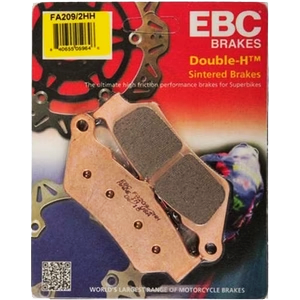Menu
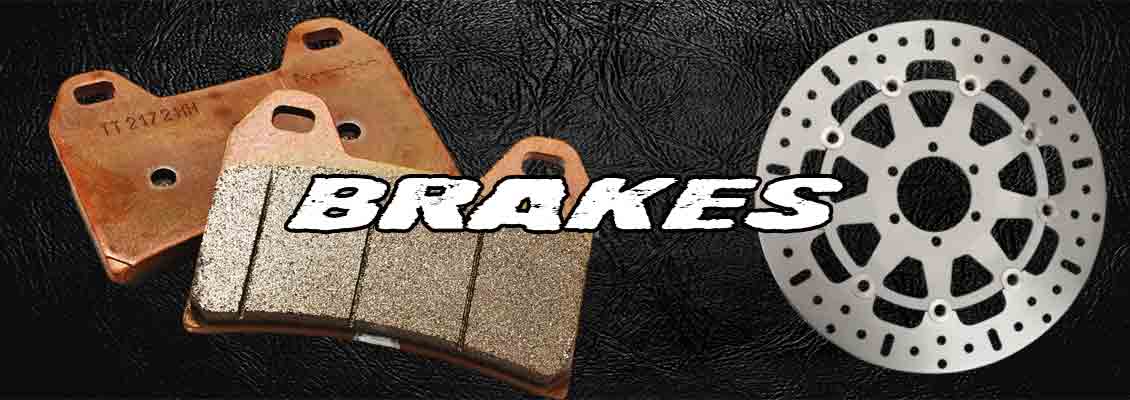
What are the Best Motorcycle Brake Pads?
One of the most important parts of your motorcycle is the braking system. It's critical to maintain, repair and replace your bike's brake pads as needed. This will ensure each time you are out on the road, your ride is as safe as possible.
When it comes to riding a motorcycle, safety is always a top priority. One of the most critical safety components on a motorcycle is the brake system. The brake pads play a crucial role in stopping your bike safely and efficiently. It's essential to choose the right ones for your needs. With a variety of brake pads available on the market, it can be overwhelming to decide which type is best for your riding style. In this edition of "Did You Know", we will discuss three of the most popular types of brake pads and their pros and cons. This will help you make an informed decision. We will help you determine how to tell if your motorcycle brake pads need changed. Lastly we will help you decide if you can change your own pads or should you take it to the dealer.
3 Types of Brake Pads-
1. Sintered Brake Pads:
Sintered brake pads are made from metal particles that are fused together under high heat and pressure. These pads are known for their durability and longevity, making them a popular choice for riders who do a lot of heavy braking or ride in extreme conditions.
Pros:
- Excellent braking performance: Sintered brake pads offer superior stopping power, especially in wet or muddy conditions.
- Long-lasting: Due to their metal construction, sintered brake pads are more resistant to wear and can last longer than other types of brake pads.
- Fade resistance: Sintered brake pads are less likely to experience brake fade, making them ideal for aggressive riding styles or riding in hilly terrain.
Cons:
- Noise and vibration: Sintered brake pads can be noisy. They may cause more vibration compared to other types of brake pads.
- Cost: Sintered brake pads tend to be more expensive than organic brake pads. This can be a downside for riders on a budget.
- Rotor wear: The metal particles in sintered brake pads can be abrasive and may cause more wear on your brake rotors over time.
2. Organic Brake Pads:
Organic brake pads are made from a mixture of materials such as rubber, glass, and Kevlar. These pads are known for providing smooth and quiet braking performance, making them a popular choice for everyday street riding.
Pros:
- Quiet operation: Organic brake pads produce less noise and vibration, providing a smooth and quiet braking experience.
- Gentle on rotors: Organic brake pads are softer than sintered pads, which can help reduce wear on your brake rotors.
- Affordable: Organic brake pads are typically more budget-friendly than sintered or ceramic brake pads. This makes them a cost-effective option for many riders.
Cons:
- Less durability: Organic brake pads wear out faster than sintered brake pads, especially under heavy braking or high temperatures.
- Reduced performance in wet conditions: Organic brake pads may not perform as well in wet conditions compared to sintered pads.
- Brake fade: Organic brake pads are more prone to brake fade under heavy or prolonged braking. This can affect stopping power.
3. Ceramic Brake Pads:
Ceramic brake pads are made from a combination of ceramic fibers and nonferrous materials. These pads are known for their smooth and consistent braking performance. This makes them a popular choice for riders looking for reliable stopping power.
Pros:
- Excellent heat dissipation: Ceramic brake pads are highly effective at dissipating heat. This can help prevent brake fade and maintain consistent braking performance.
- Low dust: Ceramic brake pads produce less brake dust than organic or sintered pads, helping to keep your wheels cleaner.
- Longevity: Ceramic brake pads have a longer lifespan than organic brake pads and can offer consistent performance over time.
Cons:
- Cost: Ceramic brake pads are typically more expensive than organic or sintered pads, which can be a deterrent for budget-conscious riders.
- Not ideal for heavy braking: While ceramic brake pads offer consistent performance, they may not provide the same level of stopping power as sintered pads under heavy braking.
- Performance in wet conditions: Ceramic brake pads may not perform as well in wet or muddy conditions compared to sintered pads, which can affect overall braking performance.
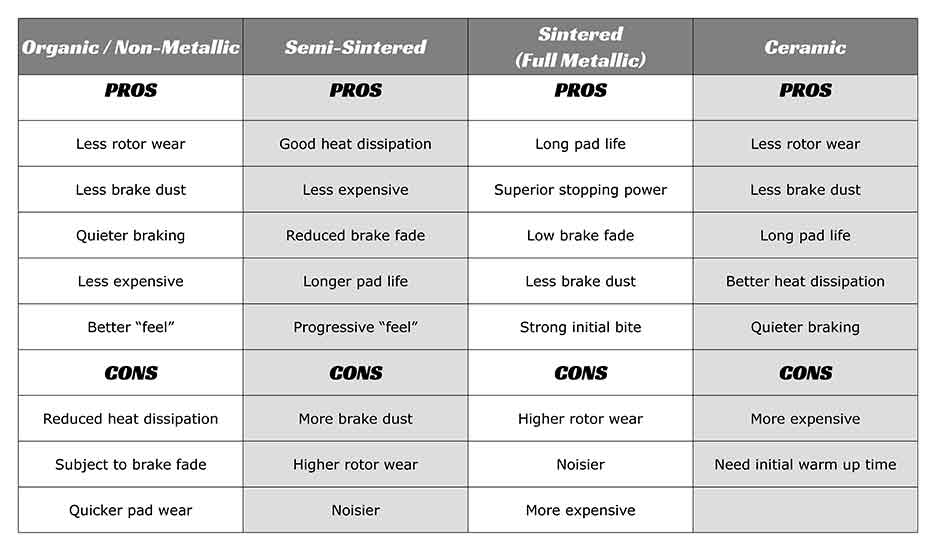
How do I know if my brake pads need replaced?
There are a few ways you can check to see if you are riding on worn brake pads and need to replace any of the other parts. Motorcycle brake pads need to be replaced when they become worn out. You can tell they are worn out when they are less than 3 millimeters thick. You may also hear a squealing or grinding noise when braking. It's important to replace brake pads to ensure proper braking performance and safety. If you are unsure, it's best to have a professional mechanic inspect and replace the brake pads.
There are several signs that indicate it is time to change your brake pads.
1. Decreased Braking Power: One of the first and most noticeable signs that your brake pads need to be replaced is a decrease in braking power. If you notice that it takes longer to stop your motorcycle or if the braking feels weak or spongy, it is likely that your brake pads are worn out.
2. Squealing or Grinding Noise:
Another common indicator that your brake pads need to be replaced is a high-pitched squealing or grinding noise when you apply the brakes. This noise is caused by the brake pad's wear indicator rubbing against the rotor. This alerts you that the brake pads are worn down and need to be replaced.

3. Thin Brake Pads: You can visually inspect your brake pads to determine their condition. If the brake pads look thin or worn down, it is a clear indication that they need to be replaced. Most brake pads have wear indicators that help you identify when they have reached the minimum thickness and require replacement.
Look For The Wear Indicator Groove.
The first step when inspecting your brake pads is to check the wear indicator groove. Most motorcycle brake pads have a groove molded or cut into the surface. This helps so you can locate how much usable area of the part is remaining.
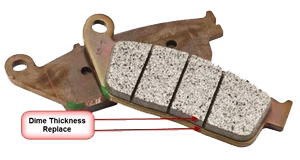 The groove disappears when the brake pad is worn enough to the point of needing to get the motorcycle parts replaced. Once the pad is down to roughly 3 millimeters, you need to replace it.
The groove disappears when the brake pad is worn enough to the point of needing to get the motorcycle parts replaced. Once the pad is down to roughly 3 millimeters, you need to replace it.
4. Vibrations or Pulsations: If you feel vibrations or pulsations in the brake lever or foot pedal when braking, it could be a sign that your brake pads are worn unevenly or are warped. This can cause the braking system to feel unstable and may result in reduced braking performance.
5. Uneven Wear: Inspect your brake pads regularly for signs of uneven wear. If you notice that one side of the brake pad is significantly more worn down than the other, it could be a sign of a caliper or rotor issue. You will need to check if it needs to be addressed along with replacing the brake pads.
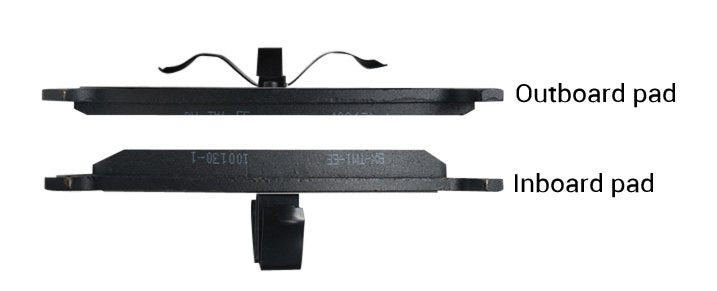
6. Mileage and Maintenance Schedule: It is important to follow the manufacturer's recommended maintenance schedule for your motorcycle, including regular inspections of the brake pads. Most manufacturers recommend changing the brake pads every 15,000-20,000 miles, but this can vary depending on your riding style, road conditions, and the type of brake pads used.
Should I change my own brake pads?
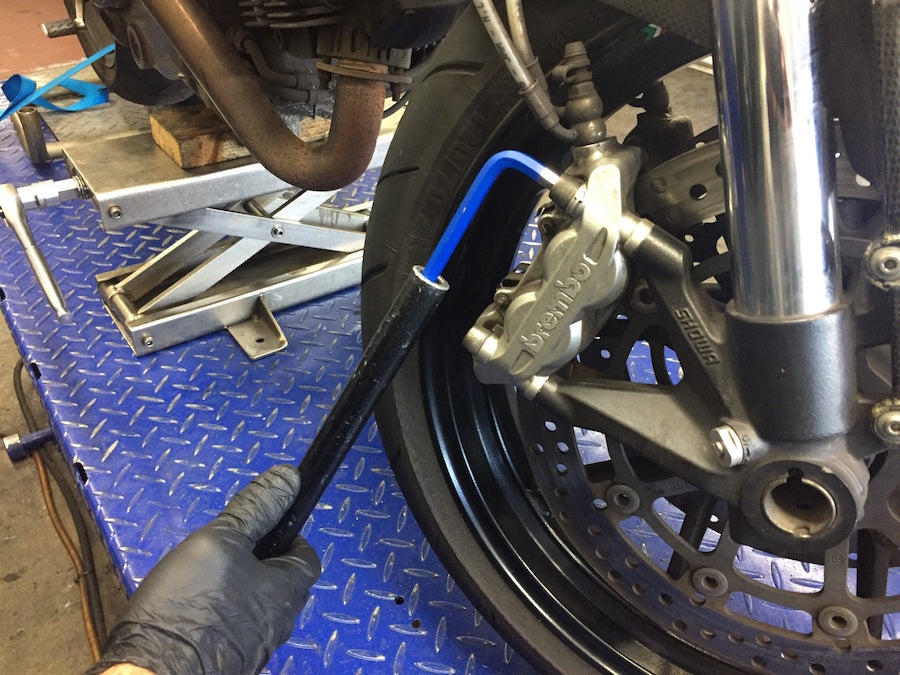
Changing your motorcycle brake pads can be a straightforward task for many riders. If you are comfortable doing basic maintenance on your motorcycle, such as oil changes, then you may feel confident in changing your brake pads.
If you have the necessary tools, such as a socket set and a c-clamp, and access to a service manual or online tutorial for your specific motorcycle model, you may be able to successfully change your brake pads.
However, if you are unsure about your mechanical abilities or do not have the necessary tools, it may be best to take your motorcycle to a professional mechanic. Additionally, if you notice any unusual noises or a decrease in braking performance, it is important to have your brake pads checked and replaced promptly. This will help ensure your safety while riding.
However, if you are unsure about your mechanical abilities or do not have the necessary tools, it may be best to take your motorcycle to a professional mechanic. Additionally, if you notice any unusual noises or a decrease in braking performance, it is important to have your brake pads checked and replaced promptly. This will help ensure your safety while riding.
In Conclusion-
Choosing the right brake pads for your motorcycle is essential for your safety and riding experience. Consider your riding style, terrain, and budget when selecting brake pads for your bike. Whether you opt for sintered, organic, or ceramic brake pads, each type has its own advantages and disadvantages. By understanding the pros and cons of each type of brake pad, you can make an informed decision that best suits your needs. Make sure to follow the manufacturer's recommendations and properly maintain your brake system to ensure optimal performance and safety on the road.
Ride Safe!
- Choosing a selection results in a full page refresh.

